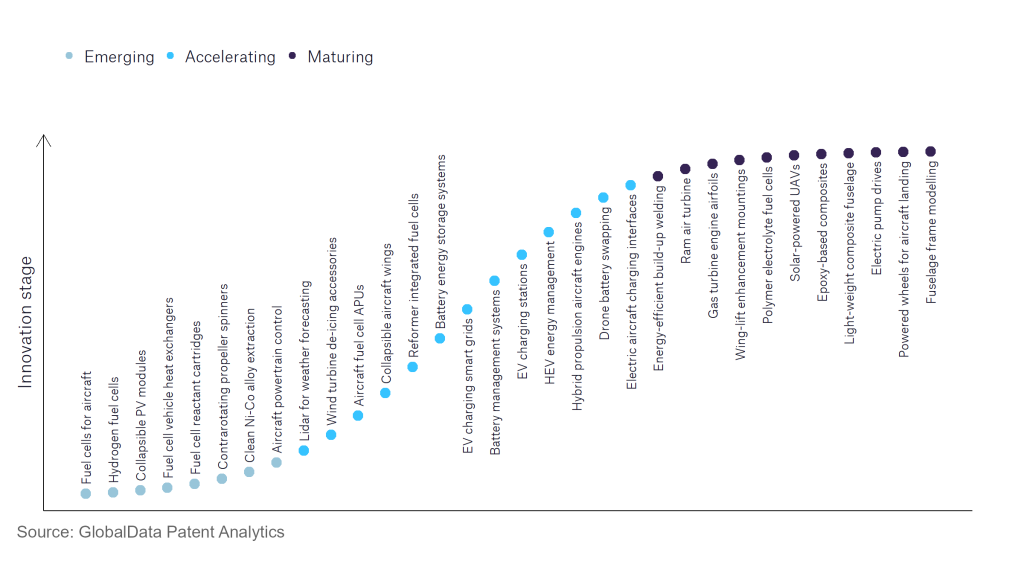The aerospace and defence industry continues to be a hotbed of innovation, with activity driven by the need to lower operational costs, larger consumer trends, and electrification, and growing importance of technologies such as hydrogen and electric aircraft and advanced materials. In the last three years alone, there have been over 174,000 patents filed and granted in the aerospace and defence industry, according to GlobalData’s report on Environment Sustainability in Aerospace, Defence & Security: Energy efficient build-up welding. Buy the report here.
However, not all innovations are equal and nor do they follow a constant upward trend. Instead, their evolution takes the form of an S-shaped curve that reflects their typical lifecycle from early emergence to accelerating adoption, before finally stabilising and reaching maturity.
Identifying where a particular innovation is on this journey, especially those that are in the emerging and accelerating stages, is essential for understanding their current level of adoption and the likely future trajectory and impact they will have.
180+ innovations will shape the aerospace and defence industry
According to GlobalData’s Technology Foresights, which plots the S-curve for the aerospace and defence industry using innovation intensity models built on over 262,000 patents, there are 180+ innovation areas that will shape the future of the industry.
Within the emerging innovation stage, hydrogen fuel cells, aircraft powertrain control, and fuel cells for aircrafts are disruptive technologies that are in the early stages of application and should be tracked closely. EV charging stations, hybrid propulsion aircraft engines, and electric aircraft charging interfaces are some of the accelerating innovation areas, where adoption has been steadily increasing. Among maturing innovation areas are fuselage frame modelling and epoxy-based composites, which are now well established in the industry.
Innovation S-curve for environmental sustainability in the aerospace and defence industry

Energy-efficient build-up welding is a key innovation area in environmental sustainability
Build-up welding is a technique where a coating is applied via a fully or partially molten phase.
GlobalData’s analysis also uncovers the companies at the forefront of each innovation area and assesses the potential reach and impact of their patenting activity across different applications and geographies. According to GlobalData, there are 20+ companies, spanning technology vendors, established aerospace and defence companies, and up-and-coming start-ups engaged in the development and application of energy-efficient build-up welding.
Key players in energy-efficient build-up welding – a disruptive innovation in the aerospace and defence industry
‘Application diversity’ measures the number of different applications identified for each relevant patent and broadly splits companies into either ‘niche’ or ‘diversified’ innovators.
‘Geographic reach’ refers to the number of different countries each relevant patent is registered in and reflects the breadth of geographic application intended, ranging from ‘global’ to ‘local’.
Patent volumes related to energy efficient build-up welding
| Company | Total patents (2021 - 2023) | Premium intelligence on the world's largest companies |
| General Electric | 280 | Unlock Company Profile |
| Raytheon Technologies | 101 | Unlock Company Profile |
| Siemens | 80 | Unlock Company Profile |
| Safran | 79 | Unlock Company Profile |
| Rolls-Royce Holdings | 50 | Unlock Company Profile |
| CDP Equity | 49 | Unlock Company Profile |
| Sulzer | 30 | Unlock Company Profile |
| Airbus | 30 | Unlock Company Profile |
| Alstom | 24 | Unlock Company Profile |
| MBDA France | 18 | Unlock Company Profile |
| Mitsubishi Heavy Industries | 12 | Unlock Company Profile |
| EOS | 12 | Unlock Company Profile |
| Redwire | 9 | Unlock Company Profile |
| CEA | 8 | Unlock Company Profile |
| European Aeronautic Defence and Space Company | 8 | Unlock Company Profile |
| SLM Solutions Group | 8 | Unlock Company Profile |
| EOS Electro Optical Systems | 8 | Unlock Company Profile |
| COSCO Shipping Holdings | 7 | Unlock Company Profile |
| Kobe Steel | 5 | Unlock Company Profile |
| Melrose Industries | 5 | Unlock Company Profile |
| Atlas Copco | 5 | Unlock Company Profile |
Source: GlobalData Patent Analytics
Raytheon Technologies is one of the leading patent filers in energy efficient build-up welding amongst aerospace and defence companies. The firm is active in the production of aircraft components through its Collins Aerospace subsidiary, and is seeking to reduce inefficiencies during the production of such components. Some other key patent filers in the aerospace and defence industry include Safran, Rolls-Royce, Airbus, and MDBA.
In terms of application diversity, Airbus holds the most widely applicable energy efficient build-up welding patents, followed by Raytheon Technologies and MBDA. Regarding geographic reach, MBDA leads the way, with EOS and Airbus in second and third place, respectively.
Energy efficient build-up welding will enable aerospace and defence companies to improve their ESG performance in their operations, reducing energy usage during the production process. Sustainable practices during operations, and enhanced system efficiencies more generally, could play a major roll in reducing the environmental impact of the sector as a whole.
To further understand the key themes and technologies disrupting the aerospace and defence industry, access GlobalData’s latest thematic research report on Defence.
Data Insights
From

The gold standard of business intelligence.
Blending expert knowledge with cutting-edge technology, GlobalData’s unrivalled proprietary data will enable you to decode what’s happening in your market. You can make better informed decisions and gain a future-proof advantage over your competitors.



